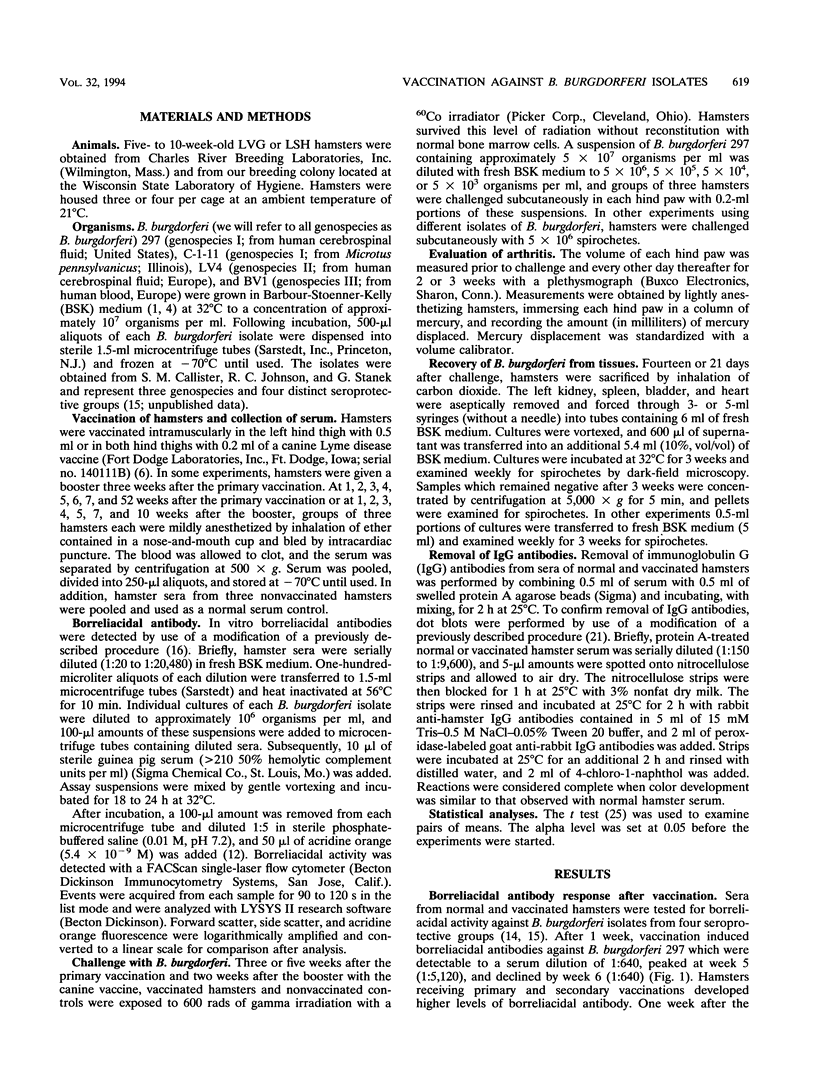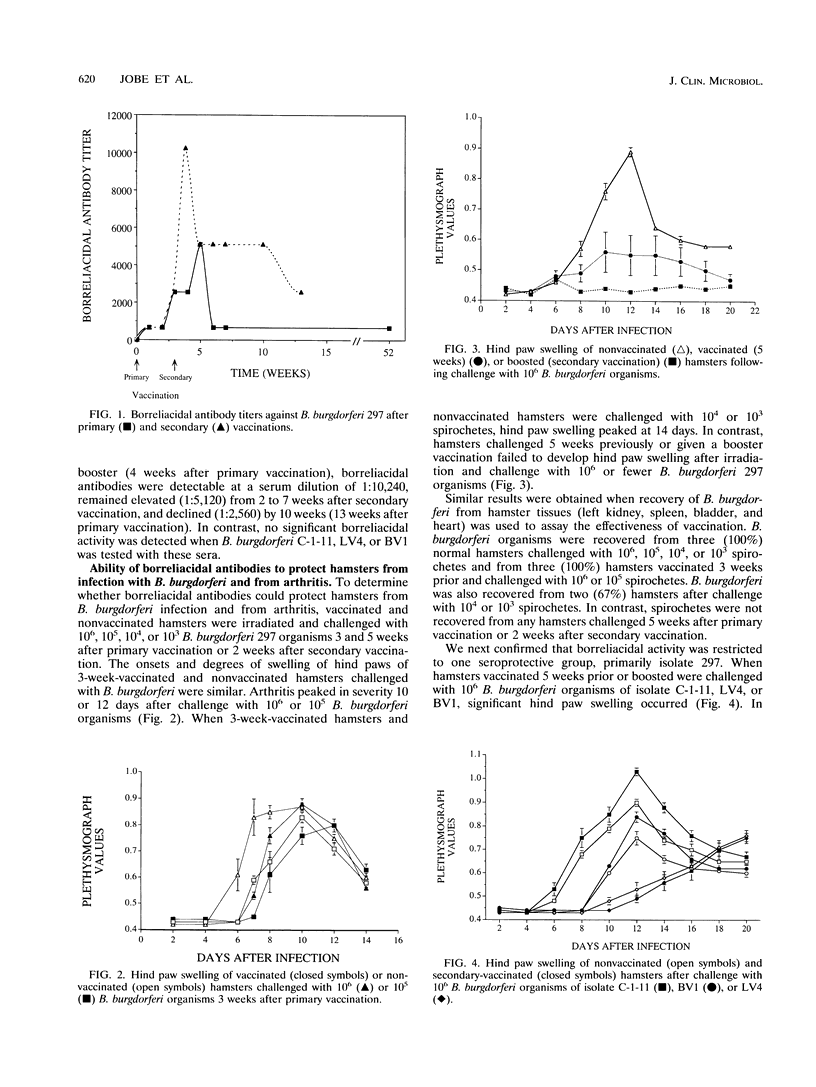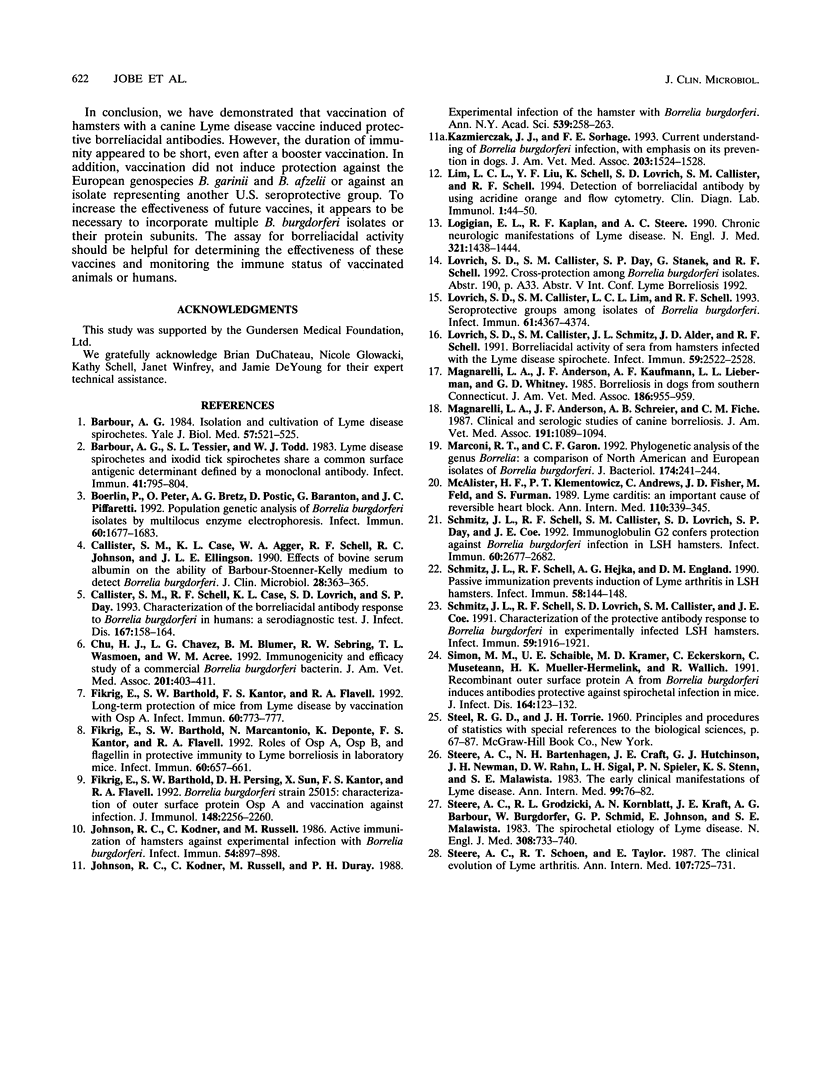Abstract
We used flow cytometry to determine levels of borreliacidal antibodies in hamsters after vaccination with a commercially available canine Lyme disease vaccine. In addition, we evaluated the ability of vaccinated hamsters to resist infection with several isolates of Borrelia burgdorferi. Borreliacidal antibodies could be detected 1 week after a primary vaccination, peaked at weeks 3 to 5, and then rapidly declined. One week after a booster vaccination, borreliacidal activity was detected at a dilution of 1:10,240, and it decreased fourfold by week 10 after the booster vaccination. Vaccinated hamsters were protected against infection with < or = 10(6) B. burgdorferi 297 organisms during the peak borreliacidal response (5 weeks after primary vaccination or 2 weeks after booster vaccination). However, hamsters were not fully protected from development of Lyme arthritis when the titer of borreliacidal antibodies was < 1:5,120. In addition, no significant borreliacidal activity was induced against B. burgdorferi C-1-11, LV4, or BV1, which belong to three other seroprotective groups. These studies demonstrate that vaccination with the canine Lyme disease vaccine induces protective antibodies against B. burgdorferi 297. However, significant levels of borreliacidal antibodies are not produced until 5 weeks after vaccination, and protection is short-lived. In addition, no borreliacidal activity was induced against other isolates of B. burgdorferi. Because of this, the incorporation of multiple isolates or protein subunits may be necessary to increase the effectiveness of future vaccines.
Full text
PDF




Selected References
These references are in PubMed. This may not be the complete list of references from this article.
- Barbour A. G. Isolation and cultivation of Lyme disease spirochetes. Yale J Biol Med. 1984 Jul-Aug;57(4):521–525. [PMC free article] [PubMed] [Google Scholar]
- Barbour A. G., Tessier S. L., Todd W. J. Lyme disease spirochetes and ixodid tick spirochetes share a common surface antigenic determinant defined by a monoclonal antibody. Infect Immun. 1983 Aug;41(2):795–804. doi: 10.1128/iai.41.2.795-804.1983. [DOI] [PMC free article] [PubMed] [Google Scholar]
- Boerlin P., Peter O., Bretz A. G., Postic D., Baranton G., Piffaretti J. C. Population genetic analysis of Borrelia burgdorferi isolates by multilocus enzyme electrophoresis. Infect Immun. 1992 Apr;60(4):1677–1683. doi: 10.1128/iai.60.4.1677-1683.1992. [DOI] [PMC free article] [PubMed] [Google Scholar]
- Callister S. M., Case K. L., Agger W. A., Schell R. F., Johnson R. C., Ellingson J. L. Effects of bovine serum albumin on the ability of Barbour-Stoenner-Kelly medium to detect Borrelia burgdorferi. J Clin Microbiol. 1990 Feb;28(2):363–365. doi: 10.1128/jcm.28.2.363-365.1990. [DOI] [PMC free article] [PubMed] [Google Scholar]
- Callister S. M., Schell R. F., Case K. L., Lovrich S. D., Day S. P. Characterization of the borreliacidal antibody response to Borrelia burgdorferi in humans: a serodiagnostic test. J Infect Dis. 1993 Jan;167(1):158–164. doi: 10.1093/infdis/167.1.158. [DOI] [PubMed] [Google Scholar]
- Chu H. J., Chavez L. G., Jr, Blumer B. M., Sebring R. W., Wasmoen T. L., Acree W. M. Immunogenicity and efficacy study of a commercial Borrelia burgdorferi bacterin. J Am Vet Med Assoc. 1992 Aug 1;201(3):403–411. [PubMed] [Google Scholar]
- Fikrig E., Barthold S. W., Kantor F. S., Flavell R. A. Long-term protection of mice from Lyme disease by vaccination with OspA. Infect Immun. 1992 Mar;60(3):773–777. doi: 10.1128/iai.60.3.773-777.1992. [DOI] [PMC free article] [PubMed] [Google Scholar]
- Fikrig E., Barthold S. W., Marcantonio N., Deponte K., Kantor F. S., Flavell R. A. Roles of OspA, OspB, and flagellin in protective immunity to Lyme borreliosis in laboratory mice. Infect Immun. 1992 Feb;60(2):657–661. doi: 10.1128/iai.60.2.657-661.1992. [DOI] [PMC free article] [PubMed] [Google Scholar]
- Fikrig E., Barthold S. W., Persing D. H., Sun X., Kantor F. S., Flavell R. A. Borrelia burgdorferi strain 25015: characterization of outer surface protein A and vaccination against infection. J Immunol. 1992 Apr 1;148(7):2256–2260. [PubMed] [Google Scholar]
- Johnson R. C., Kodner C., Russell M. Active immunization of hamsters against experimental infection with Borrelia burgdorferi. Infect Immun. 1986 Dec;54(3):897–898. doi: 10.1128/iai.54.3.897-898.1986. [DOI] [PMC free article] [PubMed] [Google Scholar]
- Johnson R. C., Kodner C., Russell M., Duray P. H. Experimental infection of the hamster with Borrelia burgdorferi. Ann N Y Acad Sci. 1988;539:258–263. doi: 10.1111/j.1749-6632.1988.tb31859.x. [DOI] [PubMed] [Google Scholar]
- Kazmierczak J. J., Sorhage F. E. Current understanding of Borrelia burgdorferi infection, with emphasis on its prevention in dogs. J Am Vet Med Assoc. 1993 Dec 1;203(11):1524–1528. [PubMed] [Google Scholar]
- Lim L. C., Liu Y. F., Schell K., Lovrich S. D., Callister S. M., Schell R. F. Detection of borreliacidal antibody by using acridine orange and flow cytometry. Clin Diagn Lab Immunol. 1994 Jan;1(1):44–50. doi: 10.1128/cdli.1.1.44-50.1994. [DOI] [PMC free article] [PubMed] [Google Scholar]
- Logigian E. L., Kaplan R. F., Steere A. C. Chronic neurologic manifestations of Lyme disease. N Engl J Med. 1990 Nov 22;323(21):1438–1444. doi: 10.1056/NEJM199011223232102. [DOI] [PubMed] [Google Scholar]
- Lovrich S. D., Callister S. M., Lim L. C., Schell R. F. Seroprotective groups among isolates of Borrelia burgdorferi. Infect Immun. 1993 Oct;61(10):4367–4374. doi: 10.1128/iai.61.10.4367-4374.1993. [DOI] [PMC free article] [PubMed] [Google Scholar]
- Lovrich S. D., Callister S. M., Schmitz J. L., Alder J. D., Schell R. F. Borreliacidal activity of sera from hamsters infected with the Lyme disease spirochete. Infect Immun. 1991 Aug;59(8):2522–2528. doi: 10.1128/iai.59.8.2522-2528.1991. [DOI] [PMC free article] [PubMed] [Google Scholar]
- Magnarelli L. A., Anderson J. F., Kaufmann A. F., Lieberman L. L., Whitney G. D. Borreliosis in dogs from southern Connecticut. J Am Vet Med Assoc. 1985 May 1;186(9):955–959. [PubMed] [Google Scholar]
- Magnarelli L. A., Anderson J. F., Schreier A. B., Ficke C. M. Clinical and serologic studies of canine borreliosis. J Am Vet Med Assoc. 1987 Nov 1;191(9):1089–1094. [PubMed] [Google Scholar]
- Marconi R. T., Garon C. F. Phylogenetic analysis of the genus Borrelia: a comparison of North American and European isolates of Borrelia burgdorferi. J Bacteriol. 1992 Jan;174(1):241–244. doi: 10.1128/jb.174.1.241-244.1992. [DOI] [PMC free article] [PubMed] [Google Scholar]
- McAlister H. F., Klementowicz P. T., Andrews C., Fisher J. D., Feld M., Furman S. Lyme carditis: an important cause of reversible heart block. Ann Intern Med. 1989 Mar 1;110(5):339–345. doi: 10.7326/0003-4819-110-5-339. [DOI] [PubMed] [Google Scholar]
- Schmitz J. L., Schell R. F., Callister S. M., Lovrich S. D., Day S. P., Coe J. E. Immunoglobulin G2 confers protection against Borrelia burgdorferi infection in LSH hamsters. Infect Immun. 1992 Jul;60(7):2677–2682. doi: 10.1128/iai.60.7.2677-2682.1992. [DOI] [PMC free article] [PubMed] [Google Scholar]
- Schmitz J. L., Schell R. F., Hejka A. G., England D. M. Passive immunization prevents induction of Lyme arthritis in LSH hamsters. Infect Immun. 1990 Jan;58(1):144–148. doi: 10.1128/iai.58.1.144-148.1990. [DOI] [PMC free article] [PubMed] [Google Scholar]
- Schmitz J. L., Schell R. F., Lovrich S. D., Callister S. M., Coe J. E. Characterization of the protective antibody response to Borrelia burgdorferi in experimentally infected LSH hamsters. Infect Immun. 1991 Jun;59(6):1916–1921. doi: 10.1128/iai.59.6.1916-1921.1991. [DOI] [PMC free article] [PubMed] [Google Scholar]
- Simon M. M., Schaible U. E., Kramer M. D., Eckerskorn C., Museteanu C., Müller-Hermelink H. K., Wallich R. Recombinant outer surface protein a from Borrelia burgdorferi induces antibodies protective against spirochetal infection in mice. J Infect Dis. 1991 Jul;164(1):123–132. doi: 10.1093/infdis/164.1.123. [DOI] [PubMed] [Google Scholar]
- Steere A. C., Bartenhagen N. H., Craft J. E., Hutchinson G. J., Newman J. H., Rahn D. W., Sigal L. H., Spieler P. N., Stenn K. S., Malawista S. E. The early clinical manifestations of Lyme disease. Ann Intern Med. 1983 Jul;99(1):76–82. doi: 10.7326/0003-4819-99-1-76. [DOI] [PubMed] [Google Scholar]
- Steere A. C., Grodzicki R. L., Kornblatt A. N., Craft J. E., Barbour A. G., Burgdorfer W., Schmid G. P., Johnson E., Malawista S. E. The spirochetal etiology of Lyme disease. N Engl J Med. 1983 Mar 31;308(13):733–740. doi: 10.1056/NEJM198303313081301. [DOI] [PubMed] [Google Scholar]
- Steere A. C., Schoen R. T., Taylor E. The clinical evolution of Lyme arthritis. Ann Intern Med. 1987 Nov;107(5):725–731. doi: 10.7326/0003-4819-107-5-725. [DOI] [PubMed] [Google Scholar]


